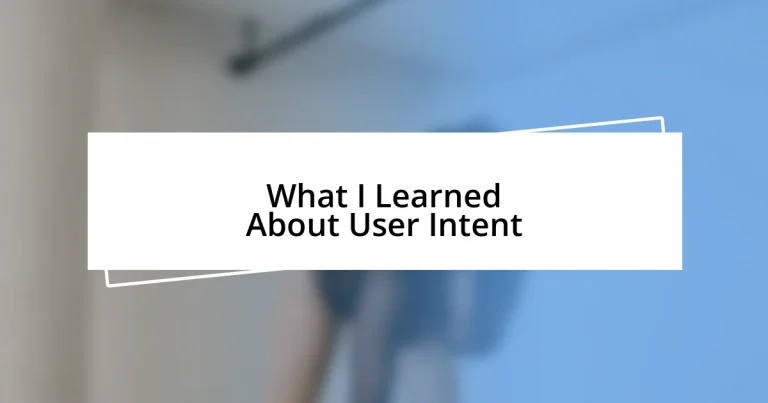Key takeaways:
- User intent encompasses various motivations behind searches, including emotional desires and practical needs, and is classified into navigational, informational, and transactional categories.
- Recognizing and addressing user intent enhances content effectiveness and connection with the audience, as it goes beyond surface-level inquiries to meet deeper emotional needs.
- Tools like Google Analytics, keyword research software, and heatmaps can help assess user intent, allowing content creators to tailor their strategies for better engagement and relevance.

Understanding user intent meanings
Understanding user intent is about diving into the reasons behind a user’s search. Have you ever typed a question into a search engine, only to realize later that what you were really looking for was something entirely different? For me, that often happens when I search for travel tips but end up craving inspiration instead. It’s a reminder that user intent can be multifaceted, ranging from informational needs to emotional desires, all shaped by individual experiences and contexts.
One time, I was browsing for “best running shoes” but found myself reading an article about the benefits of running for mental health. That unexpected journey revealed how closely linked our motivations can be. It made me ponder: Are we actually searching for products, or are we searching for feelings or solutions to deeper questions? Learning to interpret these nuances in user intent can transform how we approach content creation and marketing strategies.
Consider the various classifications of user intent—navigational, informational, and transactional. Each one paints a different picture of what the user hopes to achieve. When I plan my content, I always ask myself, “What is the underlying need for the audience?” This approach not only helps in crafting relevant material but also fosters a connection with the reader, aligning my content with their true desires and expectations.

Types of user intent
When I dive into the types of user intent, I often find myself categorizing them into three main types: navigational, informational, and transactional. Each type reflects a different goal behind a search query. For instance, when I sought directions to a new cafe, I was exhibiting navigational intent; my focus was strictly on reaching a destination. It’s fascinating how these intentions can shape our search behaviors and ultimately influence the content we engage with.
- Navigational Intent: Users are looking for a specific website or page.
- Informational Intent: Users seek answers to questions or want to learn more about a topic.
- Transactional Intent: Users aim to make a purchase or engage in a transaction.
The interplay of these intents is a reminder that for many, the digital world serves as both a guide and a companion. I vividly remember searching for “best cookware set” not just out of necessity, but out of a desire to elevate my cooking skills. That moment captured my emotional intent, blending practical needs with aspirations of culinary creativity. Understanding these nuances enables me to resonate with my audience on a deeper level.

Importance of user intent
User intent plays a crucial role in shaping the effectiveness of any online content. When I create content, I always remind myself to consider what users truly desire. For example, while researching for a new book, I often find myself not just looking for reviews, but craving recommendations that resonate with my tastes. This understanding helps me tailor my approach, ensuring that the content aligns with the user’s emotional needs, not just their surface-level inquiries.
Recognizing user intent enriches my connection with the audience. I remember a time when I was frustrated after browsing for “effective stress management techniques,” only to encounter generic advice. It frustrated me because I needed something more personal and relatable, rather than just the standard list. This experience underscored the importance of not only answering questions but addressing the underlying emotions tied to those searches. Crafting content that speaks to the heart of what users want leads to more engaging and meaningful experiences.
Additionally, user intent drives better optimization for search engines. When I focus on understanding the various motivations behind searches, it becomes clear that addressing user needs can enhance visibility. For instance, someone searching for “family-friendly vacation spots” might be looking for inspiration, convenience, or even peace of mind. By tailoring content to meet those distinct needs, I can create a stronger connection with my audience while improving the content’s chances of being discovered in a crowded digital space.
| User Intent Type | Description |
|---|---|
| Navigational Intent | Searching for a specific website or page, like “Facebook login.” |
| Informational Intent | Looking for answers to specific questions, like “benefits of meditation.” |
| Transactional Intent | Aiming to complete a purchase, like “buy running shoes online.” |

Analyzing user search behavior
When I analyze user search behavior, I often reflect on how my own search patterns reveal deeper insights into intent. Recently, while searching for a new workout routine, I realized I wasn’t just looking for exercises; I was yearning for motivation to keep my fitness journey alive. This blend of emotional and practical needs truly shaped the queries I used. Have you ever found yourself typing a search term that you thought was straightforward, only to uncover layers of what you were truly seeking?
Digging even deeper, I pay close attention to how the context of a search can shift its meaning. For example, when I was looking for “best laptop,” the intent varied significantly depending on whether I framed it as a student or a gaming device. It made me think about how important it is to consider not just the words users type, but the story behind their searches. This realization is powerful; it encourages me to fine-tune my content strategy to align with that deeper context.
Lastly, I find that seasonal trends play a substantial role in user intent. Around the holidays, for instance, I often notice my search behavior shift towards “unique gift ideas,” which reflects not just a desire for products but an underlying aspiration to connect with loved ones. It’s so interesting how external factors can influence what we seek online, isn’t it? Understanding these patterns helps me create content that resonates at just the right moment, drawing from my own experiences to make it more relatable.

Tools for assessing user intent
When it comes to assessing user intent, there are several powerful tools that I find invaluable. One of my go-to resources is Google Analytics. I particularly love how it reveals the paths users take before arriving at my content. For instance, once I noticed that many visitors landed on my site after searching for “self-care tips after a breakup.” This insight prompted me to create a dedicated blog post addressing both practical advice and emotional support, bridging the gap between what users were searching for and what they truly needed.
Another tool I lean on is keyword research software like Ahrefs or SEMrush. These tools do more than just provide search volume; they help me uncover related queries that users might not articulate explicitly. I often reflect on how a user searching for “healthy breakfast ideas” might actually be feeling overwhelmed and in need of quick, easy solutions to kickstart their day. By examining the associated keywords, I can tailor my content to ease those concerns, striking the right emotional chord.
Finally, heatmap tools such as Hotjar offer a visual representation of user engagement behavior. I recall a time when I was crafting a landing page, and after analyzing the heatmap, I noticed users clicked more on the images rather than the text. This moment was a lightbulb for me—I realized that I needed to revamp my approach, integrating more visual storytelling elements to not just attract attention but also to resonate with users emotionally. Isn’t it fascinating how a simple tool can shine a light on the nuances of user intent?

Incorporating user intent in content
When integrating user intent into my content, I often start by envisioning my audience’s specific needs and emotions. Recently, while drafting a guide on stress relief techniques, I imagined someone pacing back and forth, searching frantically for a quick solution to a mounting pile of work. This visualization makes me focus on practical, immediate tips that resonate, allowing me to address both their urgency and their emotional state. Have you ever felt that pressure and reached out for something that just clicked? That’s the magic of aligning content with intent.
In my experience, keywords alone don’t capture the full picture. They often serve as a bridge, leading me to explore the underlying motivations of my audience. I recall writing about mindfulness practices and incorporating phrases like “how to find peace in chaos.” I learned that many readers were seeking not just techniques, but a sense of calm and connection amidst their busy lives. By thoughtfully weaving in these nuances, I can create content that feels more supportive and relevant to their journey.
Ultimately, simplicity can be transformational. I remember crafting a blog post aimed at first-time homebuyers, and I consciously chose to use simple language and relatable scenarios rather than jargon-heavy explanations. This decision made my content approachable, addressing the anxiety many feel when entering the real estate market. Isn’t it interesting how a few slight adjustments in tone and content can make someone feel understood? That’s really the goal—shaping my content to echo the voices of those seeking connection and support in a digital world.












